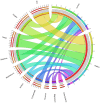Gut microbiota of children with autism spectrum disorder and healthy siblings: A comparative study
- PMID: 39328398
- PMCID: PMC11425773
- DOI: 10.3892/etm.2024.12719
Gut microbiota of children with autism spectrum disorder and healthy siblings: A comparative study
Abstract
Autism spectrum disorder (ASD) is a neurodevelopmental abnormality that impairs social communication. The human gut microbiome (GM) influences a variety of local processes, including dysbiosis and the defense against pathogenic microorganisms. The aim of the present study was to categorize and identify molecular biomarkers for ASD. In the present study, metagenomics whole genome shotgun sequencing was used to identify the gut microbiota in autistic individuals. Fecal samples from four children with ASD and four healthy control siblings, aged 3-10 years old, were examined using bioinformatics analysis. A total of 673,091 genes were cataloged, encompassing 25 phyla and 2 kingdoms based on the taxonomy analysis. The results revealed 257 families, 34 classes, 84 orders, and 1,314 genera among 4,339 species. The top 10 most abundant genes and corresponding functional genes for each group were determined after the abundance profile was screened. The results showed that children with ASD had a higher abundance of certain gut microbiomes than their normal siblings and vice versa. The phyla Firmicutes and Proteobacteria were the most abundant in ASD. The Thermoanaerobacteria class was also restricted to younger healthy individuals. Moreover, the Lactobacillaceae family was more abundant in children with ASD. Additionally, it was discovered that children with ASD had a higher abundance of the Bacteroides genus and a lower abundance of the Bifidobacterium and Prevotella genera. In conclusion, there were more pathogenic genera and species and higher levels of biomass, diversity and richness in the GM of children with ASD.
Keywords: autism; autism spectrum disorder; dysbiosis; gut microbiome; gut-brain axis.
Copyright: © 2024 Abuljadayel et al.
Conflict of interest statement
The authors declare that they have no competing interests.
Figures











References
LinkOut - more resources
Full Text Sources
